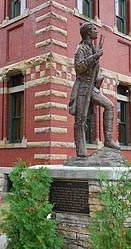1749, Oct. Christopher Gist (c.1706-1759), agent for the Ohio Company, erected stockade and trading post at Wills Creek on Potomac River.
1755, May. Under British Maj. Gen. Edward Braddock (1695-1755), stockade expanded to become Fort Cumberland.
1755, June. British Maj. Gen. Edward Braddock (1695-1755) left Fort Cumberland and led campaign through Maryland to the west.
1755, July 9. French and Indian forces mortally wounded British Maj. Gen. Edward Braddock and defeated his army at Battle of Monongahela near Fort Duquesne (present-day Pittsburgh, Pennsylvania). Afterwards, Indian attacks on western settlers increased.
1755, July 17. Braddock's aide-de-camp, George Washington, returned to Fort Cumberland.
 1767, June. Surveyors Charles Mason and Jeremiah Dixon resumed work at forks of Potomac River west of Cumberland.
1767, June. Surveyors Charles Mason and Jeremiah Dixon resumed work at forks of Potomac River west of Cumberland.
1778. General Assembly reserved all unpatented lands "westward of Fort Cumberland" for Maryland soldiers of the American Revolution.
1789. Allegany County created from western part of Washington County.
1794, Oct. 16. President George Washington called upon militia at Fort Cumberland to suppress Whiskey Rebellion in western Pennsylvania.
"The Visionary," Young George Washington statue (dedicated Dec. 2008), by Susan Luery, Allegany County Courthouse, 30 Washington St., Cumberland, Maryland, October 2014. Photo by Diane F. Evartt.
1798. Allegany County School (later Allegany Academy) founded at Cumberland (Chapter 58, Acts of 1798).
1799. First Courthouse opened at Cumberland.
![[photo, Toll Gate House, 14302 National Highway (Rte. 40), LaVale, Maryland]](/msa/mdmanual/01glance/museums/al/images/1198-1-06666c.jpg) 1815. Cumberland incorporated.
1815. Cumberland incorporated.
1818. National Road completed from Cumberland to Wheeling, now West Virginia.
1828-1848. Chesapeake and Ohio Canal constructed.
1835. George's Creek Coal and Iron Company formed.
Toll Gate House, a seven-sided structure, on old National (Cumberland) Road, 14302 National Highway (Rte. 40), LaVale, Maryland, October 2014. Photo by Diane F. Evartt.
![[photo, Lonaconing Iron Furnace & Park, Main St., Lonaconing, Maryland]](/msa/mdmanual/37mun/lonaconing/images/1198-1-11243b.jpg) 1837. Lonaconing Iron Furnace established, first in nation to use bituminous coal and coke (instead of charcoal) to make pig iron.
1837. Lonaconing Iron Furnace established, first in nation to use bituminous coal and coke (instead of charcoal) to make pig iron.
1839. Frostburg incorporated.
1841. Second Courthouse opened at Cumberland
1850, Oct. Chesapeake and Ohio Canal reached Cumberland.
1858. Westernport incorporated.
Lonaconing Iron Furnace & Park, Main St., Lonaconing, Maryland, June 2025. Photo by Diane F. Evartt.
1862, March 6. Clarysville Inn at Frostburg, transformed into military hospital for wounded Union soldiers through 1865.
1862, June 16. Confederate cavalry entered Cumberland.
1864, Aug. 1. Brig. Gen. Benjamin F. Kelly rebuffed Confederate cavalry advance near Cumberland at Folck's Mill.
1872. Garrett County formed from western part of Allegany County.
1873, May. Allegany County coal miners established Miners and Laborers Protective and Benevolent Association.
1877, July 20-22. Baltimore and Ohio Railroad strike; workers went on strike along line, demonstrated in Cumberland, went on strike, and rioted at Baltimore.
1886, Sept. 14. Mob lynched David Johnson at Westernport.
1889, May. Floodwaters inundated Cumberland.
1890. Lonaconing incorporated.
1893, Jan. 5. Courthouse in Cumberland destroyed by fire.
![[photo, Allegany County Courthouse, 30 Washington St., Cumberland, Maryland]](/msa/mdmanual/36loc/al/images/1198-1-1406a.jpg) 1894. Third Courthouse constructed at Cumberland.
1894. Third Courthouse constructed at Cumberland.
1894, April 17. At Cumberland, part of "Coxey's Army" boarded three boats down Potomac en route to Washington, DC.
1894, June. Frostburg coal strike.
Allegany County Courthouse, 30 Washington St., Cumberland, Maryland, July 2006. Photo by Diane F. Evartt.
1900. Barton incorporated.
1900. Midland incorporated.
1907. George Klotz and J. H. Britton built Lonaconing Silk Mill, also known as Klots Throwing Mill. Company flourished and turned to rayon when silk was unavailable during Great Depression and World War II. Post-war, consumer demand dropped; company closed in 1957.
1907, Oct. 6. Mob lynched William Burns at Cumberland.
1910. George's Creek Coal and Iron Company became George's Creek Coal Company.
1922. Luke incorporated.
1924, May 17. Ku Klux Klan rallied in Cumberland.
1929. Allegany County Academy closed.
1936, Nov. Strike in Cumberland at American Cellulose and Chemical Manufacturing Co. Ltd. (Celanese) plant led to recognition of union, Textile Workers of America, affiliated with Congress of Industrial Organization (CIO).
1936, March. Floods at Cumberland, National Guard called in.
1960. Conference of Appalachian Governors formed at Annapolis meeting.
1961, June. Allegany Community College (later Allegany College of Maryland) founded at Cumberland.
1963 Presidentís Appalachian Regional Commission formed.
1965, March 9. Appalachian Regional Commission established.
1968. Governor's Council for Appalachian Maryland created.
1968. Thomas B. Finan Memorial Bridge, also known as Crosstown Bridge, opened at Cumberland.
![[photo, Rocky Gap State Park, Flintstone (Allegany County), Maryland]](/msa/mdmanual/36loc/al/images/1198-1-06648b.jpg) 1970, July 17. Rocky Gap State Park opened.
1970, July 17. Rocky Gap State Park opened.
1971. Tri-County Council for Western Maryland formed.
1973. Maryland joined Interstate Mining Compact Commission.
1974. County Code Home Rule provided for self-government over local matters.
Rocky Gap State Park, Flintstone, Maryland, October 2014. Photo by Diane F. Evartt.
![[photo, Canal Place Heritage Area, C&O Canal National Historical Park, 13 Canal St., Cumberland, Maryland]](/msa/mdmanual/25ind/images/1198-1-1412a.jpg) 1976. Potomac Highlands Airport Authority created to govern Greater Cumberland Regional Airport.
1976. Potomac Highlands Airport Authority created to govern Greater Cumberland Regional Airport.
1978, Oct. Thomas B. Finan Hospital Center opened at Cumberland.
1993. Canal Place Preservation and Development Authority created.
Canal Place Heritage Area, C&O Canal National Historical Park, 13 Canal St., Cumberland, Maryland, July 2006. Photo by Diane F. Evartt.
2002, Sept. 10. Electronic voting machines first used during primary elections in four counties (Allegany, Dorchester, Montgomery, Prince George's).
2004, March 2. Electronic voting system used during primary elections at polling places and for absentee ballots in all counties and Baltimore City.
2004, May-2006, March. Eleven soldiers of 372nd Military Police Company, a reserve unit out of Cresaptown, convicted of mistreatment of prisoners at Abu Ghraib Prison, Baghdad, Iraq.
2008, March. North Branch Correctional Institution opened at Cumberland.
Search the Manual
e-mail: mdmanual@maryland.gov
|
|| Search the Archives || Education & Outreach || Archives of Maryland Online ] Governor General Assembly Judiciary Maryland.Gov
|